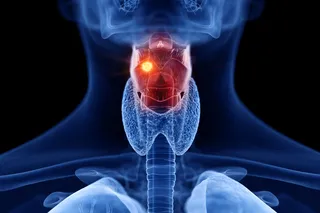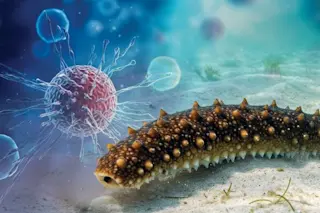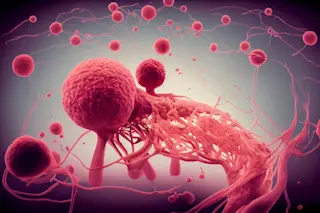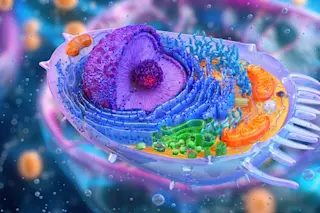One afternoon in late June, I was called to the emergency room to look over a CT scan of the brain of a young boy. The 5-year-old’s troubles had begun a while back with headaches and vision problems. After visits to his pediatrician and an ophthalmologist, he got a prescription for new glasses. The family thought the matter was solved.
Several months later, though, the child’s mother noticed that he had difficulty with balance. Then he developed early-morning headaches with nausea and vomiting. The boy’s pediatrician told his parents that he must be evaluated immediately, so they brought him to the emergency room of the Children’s Hospital in San Diego, where I am a resident in neurosurgery.
The CT scan showed dilation of the ventricles, the fluid-filled cavities in the brain. This expansion is almost always caused by a blockage, and a detailed MRI soon found the source: a tumor in a region of the brain known as the posterior fossa. This area includes the cerebellum, the part of the brain known for its role in balance and coordination.
The posterior fossa also includes the fourth ventricle, one of the main pathways through which cerebrospinal fluid, the liquid that bathes and cushions the brain, travels down to the spinal cord. If the pathway gets blocked, the fluid accumulates and presses on the brain. The pressure can cause different effects depending on what spot is being compressed. One result can be headaches and vomiting.
Unfortunately, the MRI could not tell us what kind of tumor we had found. But I knew that two types of pediatric tumors commonly occur in this part of the brain. The first is pilocytic astrocytoma, which develops when a type of supportive, nonneuronal brain cell called an astrocyte grows out of control. This type of tumor tends to develop as a nodule that is usually easy to remove.
The second is a medulloblastoma, a cancer that is thought to develop from embryonic cells that persist in the brain. Medulloblastomas are more difficult to treat—and remove—than pilocytic astrocytomas because they tend to grow in a mass that infiltrates surrounding brain tissue. We would not know which one the boy had without taking it out and analyzing it. Michael Levy, the hospital’s chief of pediatric neurosurgery, and Hal Meltzer, an attending pediatric neurosurgeon, would be participating in the surgery and treatment, which was scheduled for the next morning.
We began by drilling into the skull to insert a tube into the fluid-filled cavities so we could drain the accumulated cerebrospinal fluid and relieve the pressure. Then we cut away a small piece of the skull to get at the round, walnut-size tumor. The brain tissue below was pinkish orange, and the borders of the growth were clearly visible. We carefully excised the tumor, replaced the portion of skull we had removed, and secured it in place with screwed-in titanium plates. The operation took five hours. We left the draining tube in place to reduce pressure on the brain.
The boy’s tumor was a medulloblastoma, which carries a greater risk of recurrence or spread of the cancer to other parts of the body than pilocytic astrocytoma. Assuming he recovered from the operation, he would still have to endure chemotherapy, radiation, and continued monitoring for recurrences. He was facing a long recovery.
Following the surgery, he seemed fine. He could move and gesture. He could comprehend others. But he couldn’t speak. As the days passed, his situation did not improve.
Unfortunately, the boy had fallen victim to a poorly understood post-operative complication of posterior fossa surgery known as cerebellar mutism. His loss of speech was puzzling because the cerebellum, located at the base of the brain, is known for equilibrium—not speech production. The centers of speech production and comprehension are located in two separate regions of the cerebrum, the upper portion of the brain. These regions were first identified when researchers observed how injuries or strokes in specific parts of the brain were linked to the loss of particular functions. Sophisticated imaging of brain activity has also helped confirm the role of these regions in talking and listening.
Still, the boy’s loss of speech wasn’t completely unexpected. There have been clues that the cerebellum plays some as yet undefined role in speech. The first description of cerebellar mutism came in 1917, when World War I soldiers who suffered gunshot wounds to the cerebellum were described as having various forms of speech disorders. However, the term cerebellar mutism wasn’t coined until 1985. Since then about 200 cases have been reported in the literature. This mutism may result from a disruption of the nerves that coordinate muscles of the face and tongue, and most patients regain speech within a few weeks or months.
Over the next few weeks, I developed a close bond with the boy and his family. When his parents and 10-year-old sister visited, I would see how supportive they were and how careful they were to communicate with him by asking only yes-or-no questions he could answer with a nod. Much of the time was spent watching DVDs together. Day in and day out, I visited the child in the pediatric ward and prayed for a break in his odd prison of verbal silence.
Then one day, it seemed, this prayer was answered.
As I walked into his hospital room one day, I saw that his sister had put on a DVD of Shrek. As soon as the song “I’m a Believer” came on, the child began to sing along. Everyone in the room was astonished. We played the song over and over again, and each time he managed to get out some of the lyrics. The episode seemed to catalyze his recovery. He was soon producing words with the help of music. Within a few weeks he could once again speak normally.
How had this happened? After searching through some old texts as well as reviewing some more recent case reports, I understood that there are different pathways for different aspects of speech. For example, some stroke patients lose the ability to speak normally, but their ability to speak in song remains intact. Although some researchers had reported that the cerebellum’s relevance to speech involves the control of nerves in the oral and facial musculature that produces words, it may also be involved in somehow triggering speech. Maybe one way that can happen is through melody.
Researchers have discovered several examples of multiple or redundant pathways for the same brain function. Some believe that the multiple pathways act as a backup system to protect certain functions in case of injury. But we have just begun to scratch the surface in understanding the complexities of the brain. What we may perceive today in our limited mortal understanding as redundant or parallel may prove to be a unique function once we understand what is going on. It is through patients like this young boy and appreciating phenomena like these that we may continue to advance in our understanding.
Within a year, the boy returned to school, and he has continued to do remarkably well. His latest MRI shows no sign of recurrence or spread of the cancer. Three years have passed since we met, and I recently visited him and his family. He is doing well in school, at home, and in baseball. After his extraordinary experience, I was glad to see him enjoying all the ordinary pleasures of childhood.
Burak Ozgur is a resident at the University of California San Diego Medical Center. Cases in Vital Signs are true stories, but some details about patients are changed to protect their privacy.














